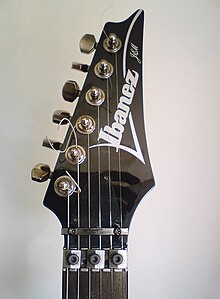Headstock
The head (and the head plate called; English head stock ) is the upper part of the guitar or bass guitar , to which the tuners are attached. The strings are stretched across the saddle to the adjusting axes of the machine heads.
There are two main forms of the head today:
- Openwork head plates with rear wings: Mainly on concert guitars
- massive headstock with lateral wings: mainly used for guitars and basses with steel strings ( electric guitar , western guitar )
The headstock is also available on other instruments, for example the banjo or mandolin .
history
In contrast to the lute, the Spanish vihuela had a flat headstock instead of the usual pegbox . The pegs - at that time still simple wooden pegs - were inserted through holes in this head plate from behind on the Vihuela. Later, with the invention of the gear mechanism, the aim was to keep the back pegs typical of the guitar and so developed the headstock, perforated by two slots, with transverse adjusting axes, as is known from today's concert guitar.
For modern guitars with steel strings, in particular the western guitar, the electric guitar and the electric bass, however, one returned to the original principle of the positioning axes inserted vertically through the plate, whereby the wings now became lateral.
Types of construction for electric guitars
There are basically two basic types:
- 3 + 3 headstocks: 3 machine heads are attached to each side of the headstock (typical for e.g. Gibson guitars)
- 6-in-line headstocks: All machine heads are attached to one side of the headstock
There are also other, rarer designs that v. a. are used for guitars with more than 6 strings.
A further subdivision of the headstock is possible via the angle to the fingerboard. On the one hand, there are angled headstocks ( droopy headstocks ), such as those installed by Gibson, for example . These are inclined at a certain angle (usually between 3 ° and 25 °) compared to the fingerboard. On the other hand, the straight head plates installed by Fender, for example, are common. The advantage of this design is the ability to manufacture the entire guitar neck from one piece of wood.
The head plates of:
- Gibson : usually with glued-on black veneer , with inlaid mother-of-pearl company name ; Mechanics three each on the right and left.
- Fender : usually wood-colored (natural-colored) headstock with glued on the company name and all mechanics on one side.
- Ibanez : usually painted headstock with the company name and machine heads stuck on one side.
In 1963 Rickenbacker developed a compact headstock for 12-string guitars with alternating side and rear machine heads
Yuri Landman built an electric guitar with a double head record, the Moonlander (2007)
Matching headstocks
For the visual enhancement of guitars, some manufacturers, such as Fender Japan, offer "Matching Headstocks". Here the headstock is adapted to the paintwork of the guitar body . Due to the additional work step, models with an adapted head plate are usually more expensive compared to standard models.





